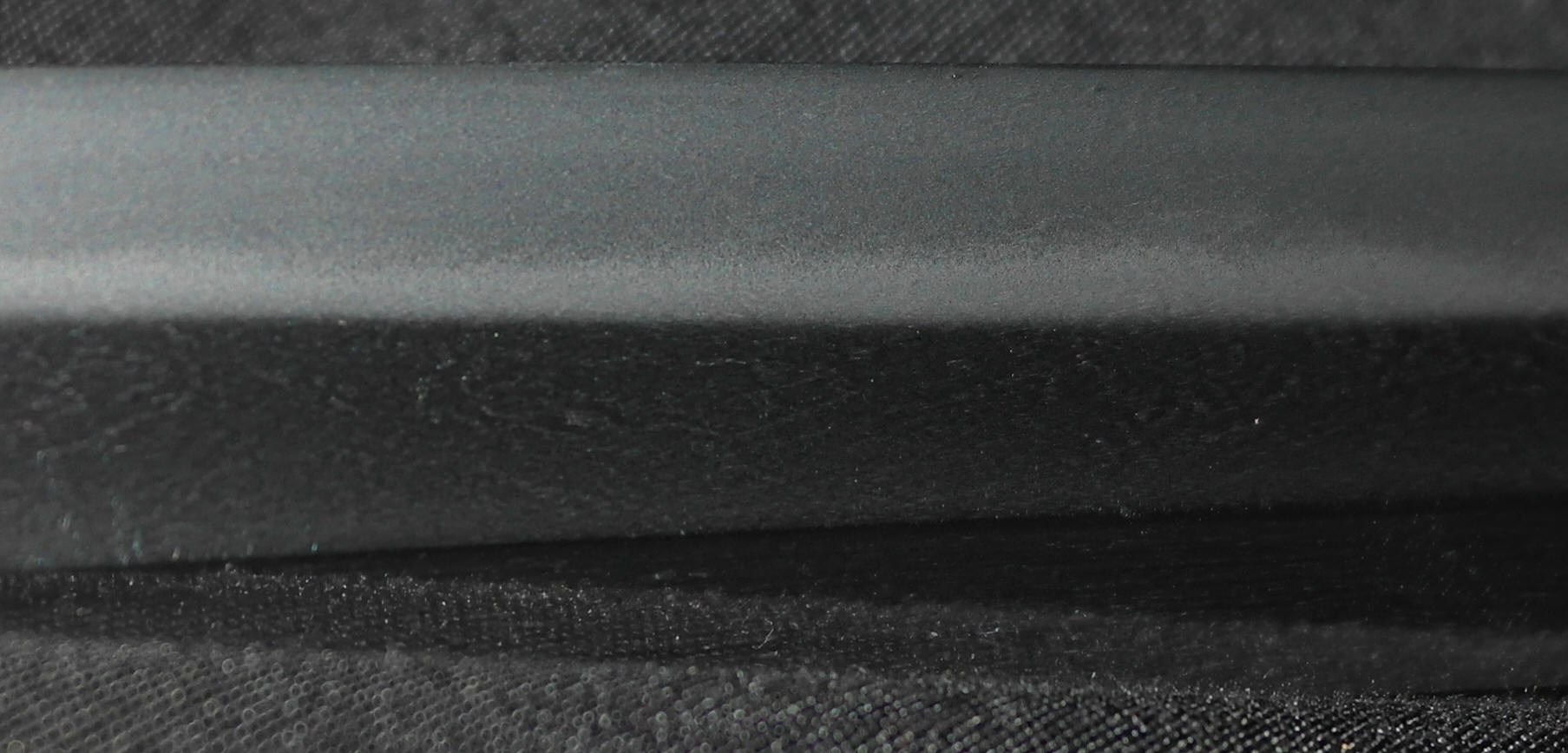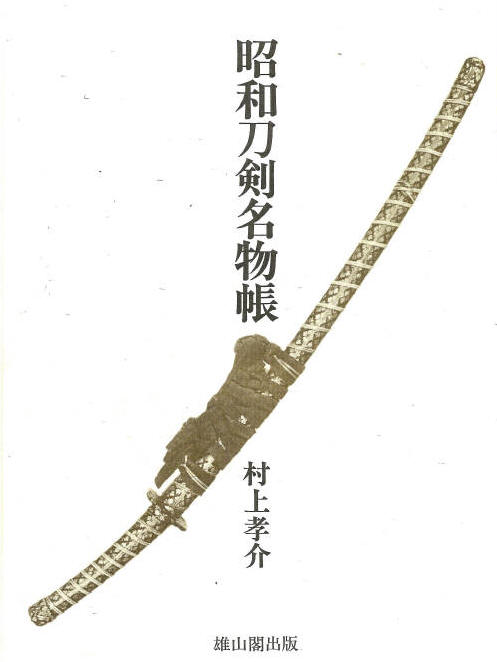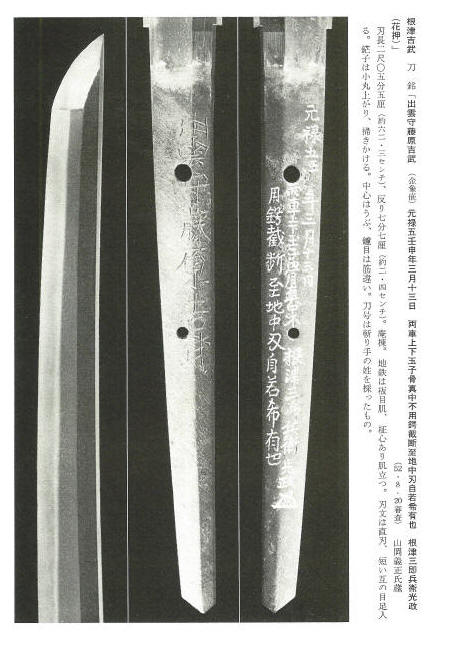
|
|
Izumo (no) kami Fujiwara Yoshitake
with rare cutting test by Nezu Mitsumasa
Published in: Showa Token Meibutsu cho
Blade nickname: Nezu-Yoshitake
NBTHK Tokubetsu Hozon



Click here to see - NBTHK Tokubetsu Hozon Kantei-sho translation

High Class Shirasaya with ebony wood inlay


"Showa Token Meibutsu cho - book cover and page"

Izumo-no-kami Fujiwara YOSHITAKE
katana (shirasaya)
Nagasa / length: 62.1cm
Sori / curvature: 2.4cm
Motohaba / width: 2.8 cm
mekugi hole: 2
(front) (kin zogan)
Genna go mizunoe-sarudoshi sangatsu jusannichi (元禄五壬申年三月十三日, “13th day of the third month Genna five [1692], year of the monkey”)
Moro-guruma ueshita tama-kobone mannaka tsuba fuyô setsudan ha wa jijaku chichû itaru keu nari (両車上下玉子骨真中不用鍔截断至地中刃自若希有也,
(“a rare blade that cut with ease and without using a tsuba with the moro-guruma cut through a body, through the pelvic bone, and into the earthen mound”)
Nezu Saburô Mitsumasa + kaô (根津三郎兵衛光政)
(back)
Izumo-no-kami Fujiwara YOSHITAKE [sword smith name]
[He is a pupil of Yamano Kauemon NAGAHISA. Expert tameshigiri. ]
Ihorimune. Itame with masa. Suguha with short gunome.
Boshi komaru.
Nakago Ubu
Published in book : Showa Token Meibutsu cho
The page quotes the mei, no additional information on the cutting
test. Just a few comments on the workmanship and that the blade's nickname,
Nezu-Yoshitake,
goes back to the smith Yoshitake and the cutting tester Nezu Saburô Mitsumasa.
Yoshitake is rated by Fujishiro at Jo-saku for superior workmanship, and Hawley grants him a high 70 points. He also has a reputation for sharp blades, earning a ranking of Wazamono.
Certified as Tokubetsu Hozon by the NBTHK.
"Cutting tests and corresponding gold inlay inscriptions became popular in the 17th century. Yamano Kanjuro, believed to be the first professional tester under the Tokugawa shogunate, is said to have performed tests on over 6,000 criminals. Nezu Saburobyoe Mitsumasa, who performed the cutting test on this sword, learned the cutting technique in the Yamano style. A four-volume handscroll detailing the secret technique of the Nezu cutting style are in the collection of the Seikado Bunko Art Museum, Tokyo. Nezu's cutting test inscriptions are extremely rare." Christies auction quote.
![]()
A interesting quote below
about the cutting test process used by Yamada that would occur prior to his cut test from the book "Tameshigiri - The History and Development of Japanese Sword Testing" By Markus Sesko page 41. Available for purchase - click here.Quote from Joly & Hogitaro´s 1913 publication
The Sword and Samé wherein we find a description of the tameshigiri procedure: "Corpses which are used for tests are supplied by the machi-bugyō on the demand of koshimono-bugyō [weapon´s magistrate of the bakufu]. On the day of the test two dotan are built, the examiner's seat is one single thin mat, the ground between the examiner's seat and tameshiba is sanded, and on it stand Yamada Asa´emon and his followers. At a fixed time, when an execution is completed, the officials return to their offices, while corpses are lying on the tameshiba with their heads. Honami the sword expert and his pupils come then, and also the consultant metsuke. The koshimono-bugyō comes later and is received by the metsuke at the entrance to the searching office. When everything is ready an announcement to that effect is made by a gaoler. All people assemble at the examiner's seat with the koshimono-bugyō and his assistant, together with swords in boxe). The metsuke is seated on the side of the tameshiba, together with the prison watchman … Yamada Asa´emon and his assistants dressed in black kimono with a band of check or stripe at the edge of the sleeves and waist ... The entrance is guarded … and the public kept out. The main gate is also guarded ... The corpse is then adjusted on the dotan by two hinin directed by Yamada Asa´emon, one man hands the blade to Asa´emon, who lifts it to his forehead and fits it into the kiri-tsuka [more on that later], then he takes off the upper kataginu part of his kamishimo and his kimono, faces the dotan and places the back of the sword on the corpse, holding the tsuka in the right hand, with the left he touches the ground and salutes the examiner. Then he stands up, grasps the sword with both hands thrown back over his head (the blade almost vertically downwards), and when all his muscles are taut he cuts the corpse with an exclamation (yah!). Hinin take off the corpse, koshimono-bugyō and other officials approach and examine the dotan, then return to their seats. Subsequently, Asa´emon reports in writing about the condition of the blade."End quote...
![]()



You may also view our CUTTING TEST BLADES SOLD IN THE PAST by clicking here
This Sword is not available for purchase.
If you wish to purchase a Japanese Sword please view our Nihon To for sale page or contact us directly via e-mail, please include specifics of what you seek, i.e.: Katana, maker, era, price range etc.
Contact Matt: at 1(815) 465-6623, Tim: at 1(608) 315-0083 any time.
Pictures and content may not be copied without the express permission of samuraisword.com © 2015